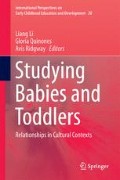Abstract
This chapter examines how toddlers develop affective relations while they play. A cultural–historical approach is used to understand affect and play. Visual methodologies are used to illustrate moments of affect in peer play. The case study involves two Australian-borne babies aged one and a half and two with Mexican and Chinese heritages, respectively. The case example analyses how transitory moments emerge when there are “affective moments of action”, as toddlers play together affectively and reciprocally. It is found that toddler’s affective actions are important in how they develop their play. Familiar games such as peek-a-boo, crawling like dogs and hop up and down like bunnies were played and shared in affective moments of action. These affective moments of action as transitory moments involved toddlers’ self-awareness of each other, change of actions and the sharing of multiple affective gazes and movements used to play collectively. Important implications for future research involve being aware of how peer play offers the exploration of toddlers’ will and agency and development of affective interest in each other’s play and games.
Access this chapter
Tax calculation will be finalised at checkout
Purchases are for personal use only
References
Alcock, S. (2009). I caught your eye, I catched your teeth. Journal of Australian Research in Early Childhood Education, 16(1), 19–33.
Arievitch, I., & Stetsenko, A. (2014). The “magic of signs” developmental trajectory of cultural mediation. In A. Yasnitsky, R. van der Veer, & M. Ferrari (Eds.), The Cambridge handbook of cultural-historical psychology (pp. 217–244). Cambridge: Cambridge University Press.
Elicker, J., Ruprecht, K. M., & Anderson, T. (2014). Observing infants’ and toddlers’ relationships and interactions in group care. In L. J. Harrison & J. Sumsion (Eds.), Lived spaces of infant-toddler education and care (pp. 131–146). Dordrecht: Springer.
Elwick, S., Bradley, B., & Sumsion, J. (2014). Infants as others: Uncertainties, difficulties and (im)possibilities in researching infants’ lives. International Journal of Qualitative Studies in Education, 27(2), 196–213.
Emde, N., Biringen, Z., Clyman, R., & Oppenheim, D. (1991). The moral self of infancy: Affective core and procedural knowledge. Developmental Review, 11, 251–270.
Fleer, M. (2014). Theorising play in the early years. Port Melbourne: Cambridge University Press.
Li, L. (2012). Family involvement in preschoolers’ bilingual heritage language development: A cultural-historical study of Chinese-Australian families’ everyday practices. ed PhD thesis, Monash University, Melbourne Australia.
Li, L. (2014). A visual dialectical methodology: Using cultural-historical analysis to unearth the family strategies in children’s bilingual heritage language development. In M. Fleer & A. Ridgway (Eds.), Visual methodologies and digital tools for researching with young children: Transforming visuality (pp. 35–53). Switzerland: Springer.
Li L., Ridgway A., & Quiñones G. (2016 under review). Transitory moment in infant/toddler play: Agentic imagination. IRECE International Research of Early Childhood Education. Special Edition.
Lokken, G. (2011). Lived experience as an observer among toddlers. In E. Johansson & E. J. White (Eds.), Educational research with our youngest: Voices of infants and toddlers (pp. 161–184). Dordrecht: Springer.
Quiñones, G. (2013). Perezhivanie Vivencia in the everyday life of children. Unpublished PhD thesis, Monash University, Melbourne Australia.
Quiñones, G. (2014). A visual and tactile path: Affective positioning of researcher using a cultural - historical visual methodology. In M. Fleer & A. Ridgway (Eds.), Visual methodologies and tools for researching with young children (pp. 111–128). Netherlands: Springer.
Quiñones, G., & Fleer, M. (2011). “Visual Vivencias”: A cultural-historical tool for understanding the lived experiences of young children’s everyday lives. In E. Johansson & J. White (Eds.), Educational research with our youngest: Voices of infants and toddlers (pp. 107–129). Dorchrect: Springer.
Ridgway, A. (2010). Using a cultural – Historical framework to show influences on learning. Unpublished PhD thesis, Monash University, Melbourne Australia.
Ridgway, A., Quiñones, G., & Li, L. (2015). Early childhood pedagogical play: A cultural-historical interpretation using visual methodology. Singapore: Springer Science series.
Rogers, S. (2010). Powerful pedagogies and playful resistance: Role play in the early childhood classroom. In L. Brooker & S. Edwards (Eds.), Engaging Play (pp. 152–165). Berkshire: Open University Press.
Singer, E. (2013). Play and playfulness, basic features of early childhood education. European Early Childhood Education Research Journal, 21(2), 172–184.
Sumsion, J., & Harrison, L. (2014). Introduction: Exploring lived spaces of infant – Toddler education and care. In L. Harrison & J. Sumsion (Eds.), Lived spaces of infant – Toddler education and care (pp. 1–16). Dordrecht: Springer.
Trevarthen, C. (2011). What is it like to be a person who knows nothing? Defining the active intersubjective mind of a newborn human being. Infant and Child Development, 20, 119–135.
Vygotsky, L. S. (1966). Play and its role in the mental development of the child. VoprosyPsikhologii (Psychology Issues), 12(6), 62–76. Translated 2015 by Myra Bars (UK) and Nikolai Veresov (Australia).
Wood, L. (2010). Reconceptualising the play – Pedagogy relationship: From control to complexity. In L. Brooker & S. Edwards (Eds.), Engaging play (pp. 11–24). Berkshire: Open University Press.
Acknowledgement
We would like to thank the families and Elvin and Silvana for making us affectively feel their play and alerting us to the wonders of playing together.
Author information
Authors and Affiliations
Corresponding author
Editor information
Editors and Affiliations
Rights and permissions
Copyright information
© 2017 Springer Nature Singapore Pte Ltd.
About this chapter
Cite this chapter
Quiñones, G., Li, L., Ridgway, A. (2017). Transitory Moments as “Affective Moments of Action” in Toddler Play. In: Li, L., Quiñones, G., Ridgway, A. (eds) Studying Babies and Toddlers. International Perspectives on Early Childhood Education and Development, vol 20. Springer, Singapore. https://doi.org/10.1007/978-981-10-3197-7_12
Download citation
DOI: https://doi.org/10.1007/978-981-10-3197-7_12
Published:
Publisher Name: Springer, Singapore
Print ISBN: 978-981-10-3195-3
Online ISBN: 978-981-10-3197-7
eBook Packages: EducationEducation (R0)

